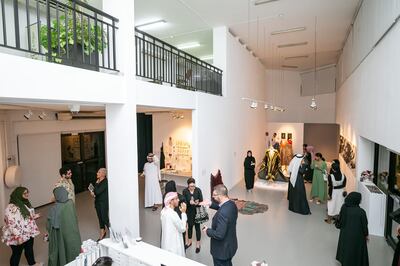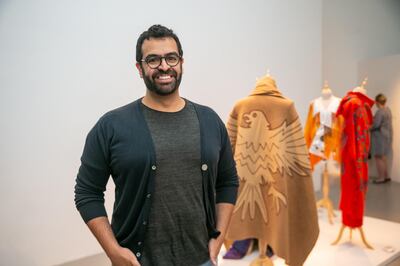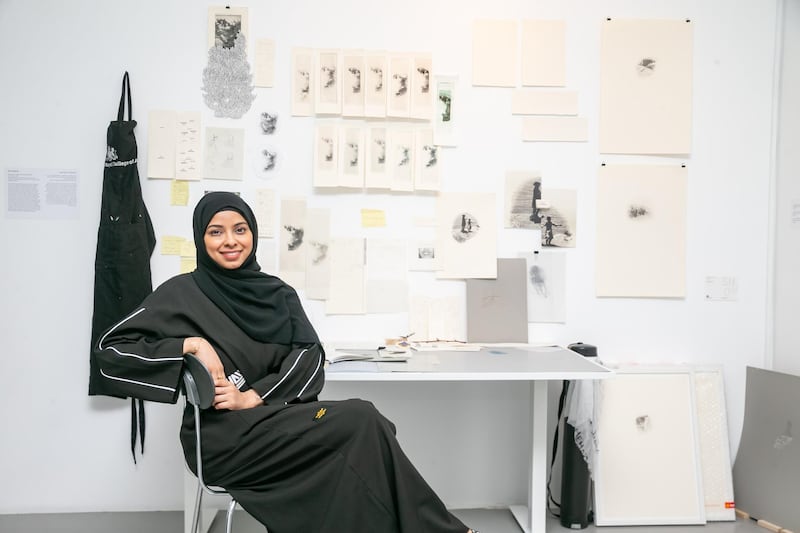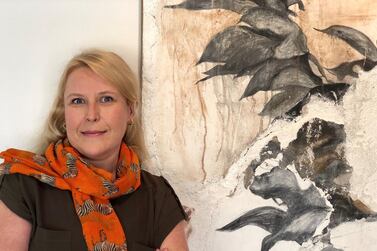A creased Post-it note with the word "confidence" written in capital letters is stuck to the wall above the desk. It is surrounded by sketches, cast-off screen-prints, an ink-stained plate used in photolithography and an artist's apron from the Royal College of Arts in London, which is hanging from a single hook. The set-up is an installation presented by Salama Nasib as a semi-replica of her studio at the RCA, from which she graduated last year after completing a master's degree in printmaking.
Upon leaving London, Nasib, 31, shipped the contents of her studio, as it was then, to her home in Dubai. Each piece of paper represents an important part of her artistic journey and is almost as precious to her as her final product: a series of photographic lithographs detailed with blind embossing that explore the notion of memory and the artist's relationship with her mother. "I have always been fascinated with the topic of memories," says Nasib. "I don't want my brain to decide what I remember and what I forget; I want to be in control. Of course, I cannot win all the time because I cannot remember everything, but that is the centre of my research."

Nasib's work is presented as part of a group exhibition at Tashkeel titled The Alumni Return. She is one of eight artists who have been associated with Tashkeel either as members or staff since its doors opened 11 years ago, and who have gone on to study master's programmes overseas.
Presented in this exhibition are their theses, either shown as final works or – as in Nasib's case – from the production and process stage. The framed works next to Nasib's replica studio exude the confidence that her self-penned note gave her during her studies. Large sheets of high-quality Somerset paper have been left mostly blank and it is this negative space that seems to engulf the faded image of Nasib and her mother that she printed using a photolithographic technique.
In the place where the shadow should be, Nasib has used blind embossing to create a raised surface, which is so delicate its presence is almost ethereal. The impetus for the series came when Nasib found an old photo album of images of herself and her mother from a time she had forgotten. "I noticed that in every single photo my mother is holding me, guiding me and looking after me, but I did not appreciate it at the time. Right now, the roles are reversed and I am caring for her, so that is why I made the embossing to represent our relationship as it is now; like a shadow of our former lives."
Lisa Ball-Lechgar, deputy director of Tashkeel, describes Nasib's work and those of the other seven artists as being part of a "strong cohort" emerging from a robust system of institutional support within the UAE. "With the support of Tashkeel and other vital institutions such as the Salama bint Hamdan Al Nahyan Foundation, Campus Art Dubai, Abu Dhabi Music and Arts Foundation and Art Jameel, the infrastructure in the UAE has grown in such a way that these artists are successfully applying for master's programmes and making great strides forward in their practice. They have done their degrees and now they are coming home. This is the right time to exhibit what we believe are pivotal moments in their careers."
Tashkeel prides itself on being a place where artists can explore different techniques and push themselves. With a process-based approach, Ball-Lechgar explains that one of the most important assets for any artist is confidence. "At Tashkeel we encourage artists to leap into the unknown and to try something new. In this show we can see two artists who usually work in graphic design specialising at a master's level in textile – a medium that they have had very little experience in before. I think this is testament to the confidence that institutions like Tashkeel give," she says.

The two artists she is referring to are Hadeyeh Badri and Khalid Mezaina. Badri, a graduate of the School of the Art Institute in Chicago, is one of the founders of the UAE's Mobius Design Studio and, until two years ago, she had not worked with textile. Her work for The Alumni Return is a tangled piece of wool yarn representing the body of her sick aunt – a subject that was at the heart of her solo exhibition at Tashkeel in 2017.
Mezaina has worked for Sharjah Art Foundation and Tashkeel as a graphic designer and programme co-ordinator. Last year, he graduated from Rhode Island School of Design with a master's degree in textile design under a scholarship from the Salama bint Hamdan Al Nahyan Foundation. His final project, Capes Make The Man, is the first presentation visitors see upon entering the group exhibition in Tashkeel. It is comprised of five wearable capes adorned with bold prints that resemble stage costumes more than fashion. "I prefer to stay away from labels. I am interested in how textiles get activated when they are worn but not from a fashion or commercial point of view. I am just a designer experimenting with material," Mezaina says.
The inspiration behind the capes came from a psychology book about the four archetypes of manliness: king, warrior, magician and lover. Mezaina, 34, says that he often asked himself questions about his place and role as a man in the UAE while he was away, so he decided to make capes representing each character archetype. "I also added one more, the dancer, because that is something important to me," he says. All five garments stand on mannequins placed on a single white plinth to symbolise the fact that they represent the different aspects of one person's psyche. The patterns are made from a series of screen-printing, dyeing and embroidery techniques and tell the story of parts of his life.
Mezaina says he feels fortunate to have received so much support in his career from institutions and says the focus now needs to be on education at home. "The institutional support evolved into scholarships to allow us to study abroad and the next step should be building programmes inside the country so that artists can pursue a masters at home in the UAE."
The Alumni Return runs until Tuesday, October 29, at Tashkeel in Nad Al Sheba, Dubai. For more information, visit tashkeel.org






